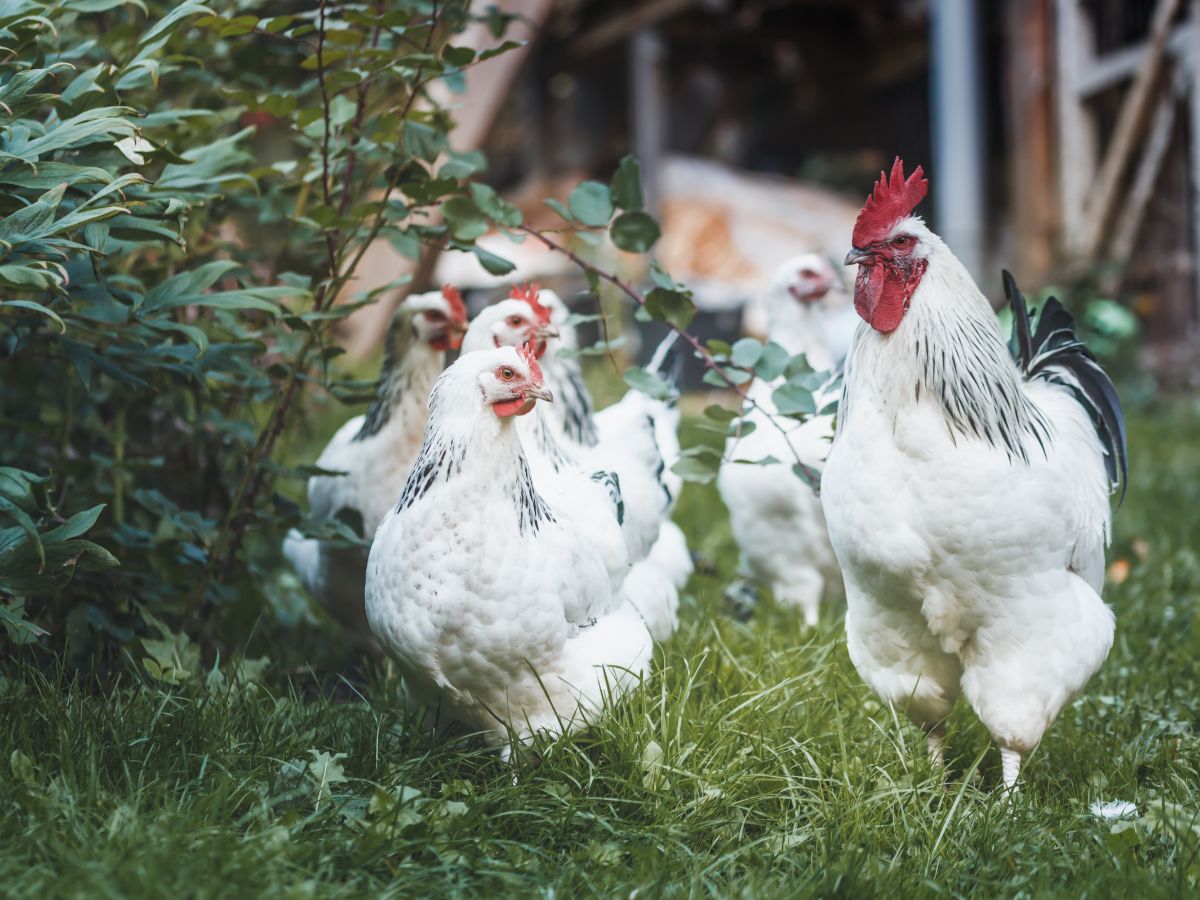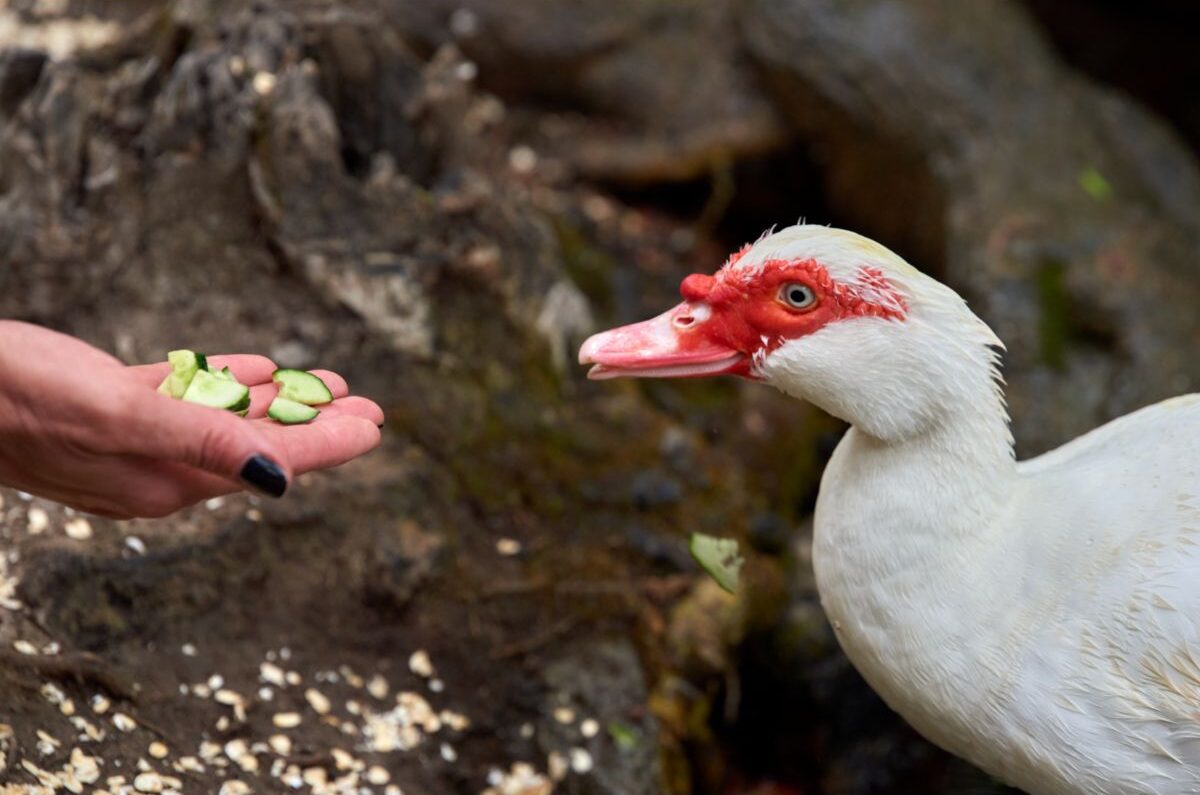The Sussex is a heritage chicken breed that has become very popular amongst backyard chicken owners. They are ideal for a small backyard flock, as they are docile and easy to manage, can produce a steady supply of eggs, and make excellent meat birds.
Sussex chickens have a variety of plumage colors – eight in total – but the speckled and light varieties are most popular. This dual-purpose breed can be standard-sized or bantam. They have a rectangular body shape, with a long, wide, flat back, wide shoulders, and a long, straight breastbone.
The Sussex is a great choice if you are eager to start a backyard flock. These chickens have a rich and interesting history that dates back to Ancient Roman times! Here, we discuss all there is to know about Sussex chickens.
Contents
Breed profile of Sussex chickens
| Beginner friendly | yes |
| Type of use | typical dual-purpose chicken |
| Egg production | 170 to 180, maximum 200 to 250 eggs per year |
| Egg size | 55g / 1.94 oz |
| Weight | Rooster 3,0 – 4,0 kg/ 6,6 – 9 lb – Hen 2,5 – 3,0 kg / 5,5 – 6,6 lb |
| Laying eggs in winter? | yes, but often much lower laying performance |
| Color | Light, Speckled, White, Silver, Red, Brown, Buff, Coronation |
| Personality | trusting and active |
| Life span | around 8 years |
| Broodiness | well developed |
| Country of origin | England (Sussex region, Kent, Surrey) |
The Origin And History Of Sussex Chickens
The Sussex is a quintessentially British breed of chicken. It is amongst the oldest chicken breeds from the United Kingdom, originating from the county of Sussex in southeast England.
In Victorian times it was fashionable to breed and show exotic poultry. Many breeds of chicken from around the world were imported, giving chicken enthusiasts more and more genetics to play with.
In the 1845 London Zoo Poultry Show (the first of its kind), the Sussex chicken was presented for the first time. It was originally called Old Sussex or Kentish fowl.
The first Standard of Excellence in Exhibition Poultry in 1865 did not include the Sussex. The breed standard for Sussex chickens was only described much later in 1902.
However, the history of the Sussex breed dates back much further than the 1800s. It is thought that the Sussex was bred from the same chickens that were found in England when the Romans invaded in 43 A.D.!
Of course, today’s Sussex chickens look very different from the Old English Game bird. Originally, they were speckled and had a reddish-brown color.
The Sussex was cross-bred with Brahma, Dorkings, and Cochins. This created the modern Sussex – a well-proportioned, robust chicken that is as beautiful as it is productive.
The Sussex Is A Dual-Purpose Chicken Breed
Generally, there are three types of chicken breeds based on their intended use: meat birds or broilers, egg-layers, and dual-purpose birds. Meat birds grow very quickly and fatten up easily. Layers have been bred so that they do not go broody and stop laying eggs.
The Sussex is a dual-purpose breed that is kept for its eggs and meat. Sussex hens have not had broodiness bred out of them, like commercial layers, so they can incubate their own eggs.
Dual-purpose chickens are ideal for a backyard flock because they can be used for meat and eggs, and it is easier to grow the size of the flock. One does not have to incubate the eggs in a brooder, and Sussex hens make great mothers.

Sussex Chicken Meat Production
Traditionally, the Sussex chicken was kept as a meat bird. Sussexes mature much more slowly than broilers, but they grow much larger. Sussex chicken is considered one of the best breeds for the table.
Sussex Chicken Egg Production
Modern Sussex chickens are regular layers that will provide you with a steady supply of eggs even through winter. Hens lay between 200 and 250 light brown eggs per year, depending on their genetics.
You can expect about 4 or 5 eggs per week from a Sussex hen. Eggs are large, weighing around 2 ounces each.
| Egg production | 170 to 180, maximum 200 to 250 eggs per year |
| Egg color | yellow to light brown, cream |
| Egg size | 55g / 1.94 oz |
Sussex Chicken Appearance
Given their history as a showing breed, Sussex chickens have a lovely appearance. If you want a beautiful backyard flock, the Sussex may be for you!
Sussex chickens have soft, dense feathers to keep them warm during winter. They do not have feathers on their feet. Pure-bred Sussex chickens have white legs and 4 toes on each foot.
Sussexes have a single comb that is usually 5-pointed. Along with their combs, their wattles and earlobes are a bright red color. Their eyes are orange to red, depending on their plumage color.
Plumage Color And Pattern
There are many different varieties of Sussex chicken to choose from, each with unique plumage color and markings:
- Light – the body is white, the tail and flight feathers are black, and the hackles around the neck are white with black penciling.
- Speckled – the body is dark mahogany brown, and there are white dapples all over the body because each feather has a white tip.
- White – the entire body is pure white without any patterns.
- Silver – the body is white, but the breast is black with silver penciling. The thighs are gray, and the neck and flight feathers are black.
- Red – the entire body is a deep, rusty red. The tail and flight feathers are black, and the neck hackles have dark penciling.
- Brown – the entire body is a dark, mahogany brown. The tail and flight feathers are black, and there is black penciling around the neck hackles.
- Buff – the body is light brown in color, and the tail and flight feathers are greenish black. The neck hackles are buff with black penciling.
- Coronation – a “special edition” Sussex that was bred for the coronation of Edward VIII (which never took place). The body is white with a lavender (light blue) tail, flight feathers, and penciling around the neck.
Silver, brown, buff, and red Sussex chickens are exceptionally rare. The most popular varieties are the light and speckled Sussex.

Body Shape And Proportions
Sussex chickens have a curvaceous, rectangular body shape. Their broad shoulders and long, flat back and breast give them a graceful appearance. They have a tail that sticks up at a 45-degree angle.
| Feathered Feet | no |
| Ring size | Rooster 22 – Hen 20 |
Size
Sussex chickens come in two sizes: standard and bantam. Standard-sized Sussex roosters reach about 9 lb, and hens grow to about 7 lb. Bantam Sussex roosters grow to about 4 lb, and hens reach about 2 lb.
Sussex Chicken Temperament
Sussex chickens are easy-going and adaptable birds. They can comfortably live in an enclosure or free range. This makes them ideal for keeping in the backyard.
Often described as docile, Sussex chickens are anything but aggressive. Even the roosters are pretty mellow and easy to handle. The Sussex chicken is ideal for people who have never kept chickens before and for families with children.
Sussex chickens are avid foragers that are excellent at finding their own food in the garden. This makes them more cost-effective to keep because you can save on the cost of chicken feed.
Sussex chickens are known for their friendliness and curiosity. Once they get to know you, they will follow you around the garden, asking for treats.
Compared to other breeds, Sussex chickens are on the quieter side. They softly chirrup and murmur to their flock mates, only making alarm calls when they get separated from the group.
Sussex roosters crow in the morning, and just before the hens lay their eggs, you will hear them making a noise. Other than that, they are well-behaved (perfect for urban areas).
Lifespan Of Sussex Chickens
Sussex chickens have a relatively long life expectancy if they are well cared for. You can bargain on a Sussex chicken living for 6 to 8 years, but many have been known to make it well past 8 years of age.
Bantam Sussex chickens tend to live longer than the standard sized. A bantam Sussex is likely to live for 10 years or even more.
How To Care For Sussex Chickens
The Sussex chicken is a low-maintenance breed that does not require any special care other than the basics. To care for a small flock of Sussex chickens, you need to do the following:
- Build your Sussex chickens a specious coop and run.
- Allow them time to free-range.
- Feed each Sussex chicken approximately a 1/4 lb of feed per day.
- Give the chickens a constant supply of fresh drinking water.
- Give them a high-protein feed* during the molting season.
- Handle Sussex chickens regularly to check their health.
- Provide plenty of shade during the summer.
- Apply a little Vaseline to their large combs during winter.
A Coop And Run Suitable For Sussex Chickens
Sussexes are large chickens that need a generous amount of space in their coop and run. Ensure that each chicken has a minimum of 4 square feet of space inside the coop. In terms of roosting space, ensure that each chicken has about 8 inches.
If you are keeping a flock of a few different breeds, be sure to give your Sussexes a little extra coop space (6 square feet per bird). Because it is such a laid-back, docile breed, they often get bullied by other breeds.
Nesting boxes that are 12 x 12 inches are perfect for Sussex chickens. Provide one nesting box for every three birds.
Because of their large size and their love for free-ranging, Sussex chickens need about 8 square feet per bird inside their run. Each bird needs enough space to scratch, dust bathe, and run around.
Allow Sussex Chickens Time To Free-Range
Let Sussex chickens out of their run to roam the garden and forage a few days per week. They enjoy scratching around and looking for bugs, worms, and greens to eat. Allowing chickens opportunities to free range is great for their health, and it keeps them mentally stimulated.

Feeding Sussex Chickens
Sussex chickens each require about a 1/4 lb of 16% protein layer feed* per day. During molting season, the chickens need a little more protein to support the re-growth of feathers. Therefore, give them a feed with 18 to 20%* protein during this time.
You can choose whether to free feed or feed them at set times. Free feeding is safe for Sussexes because they are not prone to over-eating.
Regular Health Checks
Sussex chickens are not prone to any particular health problems, but you should still check them regularly for signs of illness or parasites. Like all chickens, they can get lice, mites, and worms.
To prevent issues with these pests, you can use finely ground diatomaceous earth*. Sprinkle the dust around the coop, in the run, and specifically in popular dustbathing spots.
Illnesses and parasites often take hold in a flock when the coop and run are unhygienic. Be sure to clean the coop regularly and replace wet, soiled bedding. Also, wash feeders and waterers to prevent a build-up of bacteria.
Help Sussex Chickens Handle The Summer Heat
Sussex chickens’ heavy feathering is great for keeping them snug during winter, but during summer, it can cause them to overheat. In regions with sweltering summers, be sure to provide lots of shady hiding places for your Sussex chickens to escape the heat.
Protect Sussex Chickens’ Combs During Winter
Sussex chickens’ large combs can be vulnerable to frostbite in regions with freezing winter temperatures. This is especially true for Sussex roosters that have extra-large combs and wattles. To prevent frostbite, rub a little petroleum jelly onto roosters’ combs and wattles.
Advantages Of Sussex Chickens
Sussex chickens are a delightful breed to keep, whether in a backyard or on a homestead. These are some of the benefits of keeping Sussex chickens:
- Sussex hens keep laying eggs through the winter.
- As a dual-purpose breed, Sussexes can be used for eggs and meat.
- Their sweet, friendly temperament makes them easy to handle.
- Children can interact with them.
- Sussexes are docile and low-maintenance – perfect for first-time chicken owners.
- Their gorgeously speckled plumage makes them stunning to look at.
- Sussexes are not very noisy, so you can keep them in an urban neighborhood.
Conclusion
Sussex chickens are docile, friendly birds that are well-suited for keeping in the backyard, especially for first-time chicken owners. This adaptable, dual-purpose breed can live in a coop and run or free-range. Sussex hens are great egg-layers – you can expect 4 or 5 light brown eggs per week!
Sussex chickens originate from England and are one of the oldest chicken breeds. These beautiful birds have a variety of plumage colors and patterns, the most popular of which is the light and speckled. Sussex chickens can be standard-size and bantam-size.




